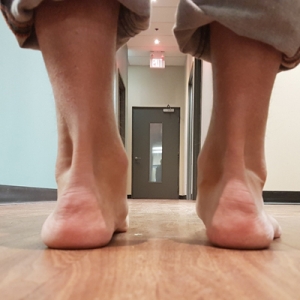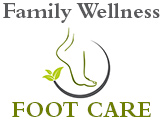The normal structure of the foot has an arch. The arch is on the medial side of the foot and is between the heel and toes.
For those people who do not have an arch, we consider them to be flat footed. You may be born with flat feet but you can also develop it over time (Adult Acquired Flat Feet). Flat feet in general are more “flexible” and “unstable” than the average foot. The proper term for flat feet is “Pes Planus”.
Newborn and toddlers generally do not have much of an arch due to the hypermobility of their joints and increased fat in the arches. As they get older, their arches will become more noticeable.
Symptoms of Flat Feet
Some people with flat feet may not experience any pain. Pain caused by flat feet is usually caused by prolonged periods of standing and walking. You may feel a dull ache or severe pain with flat feet due to the ligaments on the bottom of your foot being overstretched after long periods of activity. Shoes may wear unevenly and start to irritate the foot. As you age, you may notice your feet flattening out more or one foot more flat than your other foot.
Causative factors
Flat feet could be congenital and it can also be acquired over time. Adult acquired flat feet is usually due to the muscles, ligaments and tendons in your foot which wears down and becomes “looser”. The arches gradually collapses to the point where it becomes flat.
Complications of Flat Feet and Over Pronation
Claw Toes
With flat feet, your foot tends to roll in more than it should when you step forward. This is sometimes complicated by over pronation. Over pronation means that as weight is transferred from the outside of your foot to the inside of your foot when you step forward, the heel and the arches collapses inwards and causes a “pronation” motion.
Over pronation causes the foot to be very unstable due to the excess motion in the heel and the arch collapsing (rotating in). When your foot becomes unstable during gait, your toes will claw to try and grip the ground. An example of your toes clawing is if you picture yourself walking up an icy hill, your toes will automatically claw to stabilize and grip the ground. For someone who over pronates or has flat feet, the clawing of the toes occurs on flat even ground also, but is less noticeable than when you are walking on a slippery incline.
Continual clawing of the toes during gait will cause a muscle imbalance with the flexor and extensor tendons in the toes causing the toes to be in a clawed position. Just like any other muscle group, the more you walk (the more the toes claw), the stronger the tendons become and the more noticeable the hammer and claw toes become.
Bunions
Bunions are a bony deformity of the 1st metatarsal phalangeal joint where the toe begins to angle towards the 2nd toe. It is common in people that have flat feet and over pronate because of a muscle imbalance of the first toe joint. Bunions become painful because your foot becomes wider and the bunion may start rubbing in the shoe. The shift in the placement of the joint may cause limited range of motion and pain with every step.
Treatment options
Generally stretching and custom orthotics is all that is needed to treat flat feet. Custom orthotics are plastic insoles molded to your foot in a non-weight bearing position. The thickness of the orthotic is determined by your weight. The heavier you are, the thicker the orthotic. The lighter you are, the thinner the orthotic. Custom orthotics are not a one size fits all. The orthotic acts as a brace, and “braces” your arch to prevent your foot from flattening out.
What We Will Do
It is important to see a foot specialist to be assessed for flat feet. If you have pain or discomfort, or wanted a proper diagnosis of your foot, book in and get your foot assessed! If treatment is started early, it could prevent future issues from arising! On your initial visit for flat feet, you can expect the following to be done:
- Stretching exercises will be given.
- Footwear recommendations will be given.
- Biomechanical assessment will be performed to assess the way you stand and the way you walk dynamically
- Orthotics may be prescribed to stabilize your arch
- Topical/or oral anti-inflammatory medications may be prescribed to reduce pain or discomfort
Please feel free to book your appointment at our Whitby office, or Toronto Office. Now serving- Bowmanville, Courtice, Oshawa, Whitby, Brooklin, Ajax, Durham, Pickering, Scarborough, Toronto, Etobicoke, Mississauga, Richmond Hill, Markham, Thornhill.

